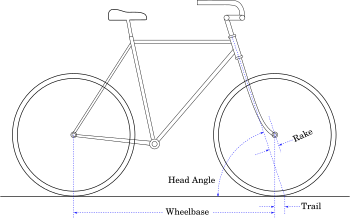I can get my head round most of the steering variables but one that completely baffles me is why some motor manufacturers build negative trail into an upright. Can anyone explain this oddball need, I know in the locost world in takes away a lot of the self centering effect of caster. All that I can find on this relates to bikes.
Bob
From Wiki
Trail


Bicycle
head angle,
rake, and trail
A factor that influences how easy or difficult a bike will be to ride is
trail, the distance that the front wheel ground contact point trails behind the steering axis ground contact point. The steering axis is the axis about which the entire steering mechanism (fork, handlebars, front wheel, etc.) pivots. In traditional bike designs, with a steering axis tilted back from the vertical, positive trail tends to steer the front wheel into the direction of a lean, independent of forward speed.
[26] This can be simulated by pushing a stationary bike to one side. The front wheel will usually also steer to that side. In a lean, gravity provides this force. The dynamics of a moving bike are more complicated, however, and other factors can contribute to or detract from this effect.
[1]
Trail is a function of head angle, fork offset or rake, and wheel size. Their relationship can be described by this formula:
[36]
where
is wheel radius,
is the head angle measured clock-wise from the horizontal and
is the fork offset or rake. Trail can be increased by increasing the wheel size, decreasing or slackening the head angle, or decreasing the fork rake.
The more trail a traditional bike has, the more stable it feels,
[37] although too much trail can make a bike feel difficult to steer. Bikes with negative trail (where the contact patch is actually in front of where the steering axis intersects the ground), while still ridable, are reported to feel very unstable. Normally, road racing bicycles have more trail than touring bikes but less than mountain bikes. Mountain bikes are designed with slacker head angles than road bikes to improve stability for descents, and therefore have greater trail. Touring bikes are built with small trail to allow the rider to control a bike weighed down with baggage. As a consequence, an unloaded touring bike can feel unstable. In bicycles,
fork rake, often a curve in the fork blades forward of the steering axis, is used to diminish trail.
[38] Bikes with negative trail exist, such as the Python Lowracer, and are ridable, and an experimental bike with negative trail has been shown to be self-stable.
[1]
In motorcycles, rake refers to the head angle instead, and offset created by the
triple tree is used to diminish trail.
[39]
A small survey by Whitt and Wilson
[26] found:
- touring bicycles with head angles between 72° and 73° and trail between 43 mm and 60 mm
- racing bicycles with head angles between 73° and 74° and trail between 28 mm and 45 mm
- track bicycles with head angles of 75° and trail between 23.5 mm and 37 mm.
However, these ranges are not hard and fast. For example,
LeMond Racing Cycles offers
[40] both with forks that have 45 mm of offset or rake and the same size wheels:
- a 2006 Tete de Course, designed for road racing, with a head angle that varies from 71¼° to 74°, depending on frame size, and thus trail that varies from 51.5 mm to 69 mm.
- a 2007 Filmore, designed for the track, with a head angle that varies from 72½° to 74°, depending on frame size, and thus trail that varies from 51.5 mm to 61 mm.
The amount of trail a particular bike has may vary with time for several reasons. On bikes with front suspension, especially telescopic forks, compressing the front suspension, due to heavy braking for example, can steepen the steering axis angle and reduce trail. Trail also varies with lean angle, and steering angle, usually decreasing from a maximum when the bike is straight upright and steered straight ahead.
[41] Trail can decrease to zero with sufficiently large lean and steer angles, which can alter how stable a bike feels.
[10] Finally, even the profile of the front tire can influence how trail varies as the bike is leaned and steered.
A measurement similar to trail, called either
mechanical trail,
normal trail, or
true trail,
[42] is the
perpendicular distance from the steering axis to the centroid of the front wheel contact patch.






